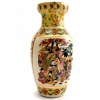|
 I want to have a porcelain set ... It should be thin as a nymphs sigh,
transparent, as a teardrop of child, tender as cloud and weightless like the
idea. Porcelain. What makes it the miracle? Is it possible to classify, drive this imponderable miracle into a frame? It turns
out to be quite simple challenge. So, Сhina is classified by country of production. I want to have a porcelain set ... It should be thin as a nymphs sigh,
transparent, as a teardrop of child, tender as cloud and weightless like the
idea. Porcelain. What makes it the miracle? Is it possible to classify, drive this imponderable miracle into a frame? It turns
out to be quite simple challenge. So, Сhina is classified by country of production.
China:
the birthplace of porcelain. Till these days there are disputes about whether porcelain
produced in other regions is better than the one in the place of its derivation.
Objectively, it is impossible to estimate, so the choice is the matter of taste.
The crockery is still divided by periods according
to Chinese dynasties:
Sun:
simple, quiet forms. An important feature is that it was period of free using improved
sparry glazes that gave muted color and wealth
delicate shades of red, purple, blue and greenish
colors.
Ming: the
use of light relief on thin porcelain led makes remarkable
grace. Most subtle, almost transparent sides, the drawing light
relief are made with the help of causing liquid porcelain mass under coated;
lightweight proportions are the main achievements in production of Ming
dynasty. Each of these products is a unique a work of
art.
It is worth recalling that the porcelain of the
era is not used as dish nowadays. It is a pride, a kind of antiques, jewelry,
and collectors and museums are hunting for it.
Modern Chinese porcelain is little easier and more
punch, but unique copies are still created very often.
Japan:
is it different variety of forms and styles, a wide range of techniques
used in the manufacturing. Japanese porcelain is easily
distinguished by its special «Samuraj» style with
very expressive paintings and surprisingly strong fragility
...
Major manufacturers are located in Kutani, Kyoto,
Hirado, Arita.
Europe
began producing porcelain almost recently. The secret of porcelain manufacture was jealously
guarded, and oriental porcelain has been great rarity in
Europe, even to the 15 century. They appeared only
in the royal yards as gifts or bribes to European monarch. Only in the early
16 century Portuguese brought the first sample of kaolin to Europe in «detective»
way, but even that didn't not closer the European masters to the secret. Only in
the 18-th century German alchemist and forger Betterom finally produced the
first European porcelain. In 1710 Saxon kurfyurst and Polish King August Strong ordered to
build the first European porcelain plant at the castle Albrehtsburg
in the town of Mays.
Austria
is known worldwide thanks to mild forms of fine, clean lines and sophistication. Well-known manufacturers are Augarten, Meissen.
Germany:
traditional quality, less glamorous colors, pleasing design and moderate
prices. One of the world-famous producers is Villeroy & Boch. If you
trust the statistics, each European family enjoys having some dishes of that
mark. This is not a surprise, as the brand is already 250 years old. Villeroy
& Boch is a way of life. Tablecloths, wallpaper and even furniture are
chosen to suit these dishes.
The popularity of German porcelain is largely due
to remarkable artist Johann Heroldtu, who created the product in the style
shinuazri invented the decoration of flowers seeming alive, also
known as the «German Flowers », as well as outstanding sculptor Johann
Kendleru known for his small plastic arts in the Rococo style and famous
sculptural characters like Italian Commedia dell'Arte.
Britain:
British are known for loving tea party, and English
china is famous for its beautiful flowers on the cups, plates
and sets. England was at the
forefront of producing porcelain due to its great colonial power, as East India campaign
traded with China
as well.
England is also famous for changing the classic
Chinese tea-service, adopting it to their needs. Cups are unlike the
Chinese cups, limpets, teapots, sugar bowls, and teaspoons: all
these
traditional attributes of English tea have been
created specifically in order to enjoy the tea ceremony in European style.
Natalya Rudenko
|